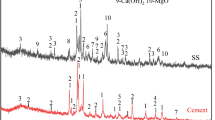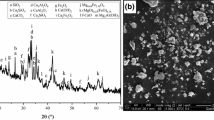Abstract
Utilization of steel slag as a supplementary cementitious material is limited due to its poor volume stability and weak hydration activity. Moreover, the alkaline minerals of steel slag make it highly susceptible toward carbonation. Thus, this study aims to analyze the impact of accelerated precarbonation on the volume stability and hydration activity of steel slag. To this end, through exposing steel slag to CO2 for accelerated carbonation, mortars and pastes containing 30% carbonated steel slag were prepared and their compressive strength and volume expansion were measured. The results indicate steel slag shows a rapid carbonation rate in the first three minutes and reaches an extent of carbonation of 15.55%. Furthermore, the 3-day compressive strength of the mortars containing the steel slag carbonated for one and three minutes increases by 17.0 and 5.7%, respectively, which is attributed to the “nucleation site” of the calcite and calcium silicate hydrate (C–S–H) formed in the accelerated precarbonation progress. However, the compressive strength of the mortar obviously drops with an increase in carbonation time due to the consumption of the minerals of the steel slag. On the contrary, the volume stability of steel slag strongly depends on accelerated precarbonation time and it positively relates to carbonation degree. Thus, a balance between the hydration activity and volume stability of the steel slag should be achieved by adjusting the accelerated precarbonation conditions.










Similar content being viewed by others

References
Furlani E, Tonello G, Maschio S. Recycling of steel slag and glass cullet from energy saving lamps by fast firing production of ceramics. Waste Manag. 2010;30:1714–9.
Doucet FJ. Effective CO2-specific sequestration capacity of steel slags and variability in their leaching behavior in view of industrial mineral carbonation. Minerals Eng. 2010;23:262–9.
Bonenfant D, Kharoune L, Sauv ESEB, et al. Molecular analysis of carbon dioxide adsorption processes on steel slag oxides. Int J Greenh Gas Con. 2009;3:20–8.
Hanein T, Galvez-Martos J, Bannerman MN. Carbon footprint of calcium sulfoaluminate clinker production. J Clean Prod. 2018;172:2278–87.
Xu D, Cui Y, Li H, et al. On the future of Chinese cement industry. Cement Concrete Res. 2015;78:2–13.
Isteri V, Ohenoja K, Hanein T, et al. Production and properties of ferrite-rich CSAB cement from metallurgical industry residues. Sci Total Environ. 2020;712:136208.
Bodor M, Santos RM, Kriskova L, et al. Susceptibility of mineral phases of steel slags towards carbonation: mineralogical, morphological and chemical assessment. Eur J Minera. 2013;25:533–49.
Shi C. Steel slag-its production, processing, characteristics, and cementitious properties. J Mater Civil Eng. 2004;16:230–6.
Han F, Zhang Z, Wang D, et al. Hydration heat evolution and kinetics of blended cement containing steel slag at different temperatures. Thermochim Acta. 2015;605:43–51.
Wang Q, Yan P. Hydration properties of basic oxygen furnace steel slag. Constr Build Mater. 2010;24:1134–40.
Belhadj E, Diliberto C, Lecomte A. Properties of hydraulic paste of basic oxygen furnace slag. Cement Concrete Comp. 2014;45:15–21.
Brand AS, Roesler JR. Steel furnace slag aggregate expansion and hardened concrete properties. Cement Concrete Comp. 2015;60:1–9.
Lun Y, Zhou M, Cai X, et al. Methods for improving volume stability of steel slag as fine aggregate. J J Wuhan Univ Technol. 2008;23:737–42.
Huijgen WJ, Witkamp G, Comans RN. Mineral CO2 sequestration by steel slag carbonation. Environ Sci Technol. 2005;39:9676–82.
Humbert PS, Castro-Gomes J. CO2 activated steel slag-based materials: a review. J Clean Prod. 2019;208:448–57.
Huijgen WJJ, Witkamp G, Comans RNJ. Mechanisms of aqueous wollastonite carbonation as a possible CO2 sequestration process. Chem Eng Sci. 2006;61:4242–51.
Baciocchi R, Costa G, Di Bartolomeo E, et al. Wet versus slurry carbonation of EAF steel slag. Greenh Gases. 2011;1:312–9.
Baciocchi R, Costa G, Di Bartolomeo E, et al. Carbonation of stainless steel slag as a process for CO2 storage and slag valorization. Waste Biomass Valor. 2010;1:467–77.
Capobianco O, Costa G, Thuy L, et al. Carbonation of stainless steel slag in the context of in situ Brownfield remediation. Miner Eng. 2014;59:91–100.
Tian S, Jiang J, Chen X, et al. Direct gas-solid carbonation kinetics of steel slag and the contribution to in situ sequestration of flue gas CO2 in steel-making plants. Chemsuschem. 2013;6:2348–55.
Ibrahim MH, El-Naas MH, Zevenhoven R, et al. Enhanced CO2 capture through reaction with steel-making dust in high salinity water. Int J Greenh Gas Con. 2019;91:102819.
Ghouleh Z, Guthrie RIL, Shao Y. High-strength KOBM steel slag binder activated by carbonation. Constr Build Mater. 2015;99:175–83.
Cao W, Yang Q. Properties of a carbonated steel slag-slaked lime mixture. J Mater Civil Eng. 2015;27:4014115.
Librandi P, Nielsen P, Costa G, et al. Mechanical and environmental properties of carbonated steel slag compacts as a function of mineralogy and CO2 uptake. J CO2 Util. 2019;33:201–14.
Jo H, Lee M, Park J, et al. Preparation of high-purity nano-CaCO3 from steel slag. Energy. 2017;120:884–94.
Wang D, Fang Y, Zhang Y, et al. Changes in mineral composition, growth of calcite crystal, and promotion of physico-chemical properties induced by carbonation of β-C2S. J CO2 Util. 2019;34:149–62.
Sato T, Beaudoin JJ. Effect of nano-CaCO3 on hydration of cement containing supplementary cementitious materials. Adv Cem Res. 2011;23:33–43.
Wang X. Effect of nano-CaCO3 on properties of cement paste. Energy Procedia. 2012;16:991–6.
Sun J, Shi H, Qian B, et al. Effects of synthetic C–S–H/PCE nanocomposites on early cement hydration. Constr Build Mater. 2017;140:282–92.
GB/T 17671-1999: Methods of testing cements-determination of strength. The state bureau of quality and technical supervision, China.
GB/T 750-1992: Autoclave method for soundness of Portland cement. The state bureau of quality and technical supervision, China.
Saito T, Sakai E, Morioka M, et al. Carbonation of γ-Ca2SiO4 and the mechanism of vaterite formation. J Adv Concr Technol. 2010;8:273–80.
Chang J, Fang Y, Shang X. The role of β-C2S and γ-C2S in carbon capture and strength development. Mater Struct. 2016;49:4417–24.
Mo L, Zhang F, Deng M. Mechanical performance and microstructure of the calcium carbonate binders produced by carbonating steel slag paste under CO2 curing. Cement Concrete Res. 2016;88:217–26.
Huijgen WJJ, Comans RNJ. Carbonation of steel slag for CO2 sequestration: leaching of products and reaction mechanisms. Environ Sci Technol. 2006;40:2790–6.
Chang J, Wang D, Fang Y. Effects of mineralogical changes in BOFS during carbonation on pH and Ca and Si leaching. Constr Build Mater. 2018;192:584–92.
Chang EE, Chiu A, Pan S, et al. Carbonation of basic oxygen furnace slag with metalworking wastewater in a slurry reactor. Int J Greenh Gas Con. 2013;12:382–9.
Wu Z, Shi C, Khayat KH. Multi-scale investigation of microstructure, fiber pullout behavior, and mechanical properties of ultra-high performance concrete with nano-CaCO3 particles. Cement Concrete Comp. 2018;86:255–65.
Bentz DP, Ardani A, Barrett T, et al. Multi-scale investigation of the performance of limestone in concrete. Constr Build Mater. 2015;75:1–10.
Bentz DP, Sato T, de la Varga I, et al. Fine limestone additions to regulate setting in high volume fly ash mixtures. Cement Concrete Comp. 2012;34:11–7.
Pedrosa HC, Reales OM, Reis VD, et al. Hydration of Portland cement accelerated by C–S–H seeds at different temperatures. Cement Concrete Res. 2020;129:105978.
Fza B, Ch A, Fwa B, et al. Enhancement of early-age strength of the high content fly ash blended cement paste by sodium sulfate and C–S–H seeds towards a greener binder. J Clean Prod. 2019;244:118566.
Hosan A, Shaikh FUA. Influence of nano-CaCO3 addition on the compressive strength and microstructure of high volume slag and high volume slag-fly ash blended pastes. Build Eng. 2020;27:100929.
John E, Epping JD, Stephan D. The influence of the chemical and physical properties of C–S–H seeds on their potential to accelerate cement hydration. Constr Build Mater. 2019;228:116721–3.
Zhang C, Cai Y, Kong X, et al. Influence of nano C–S–H on cement hydration, pore structure of hardened cement pastes and strength of concrete. J Chin Ceramic Soc. 2019.
Cao M, Ming X, He K, et al. Effect of macro-, micro- and nano-calcium carbonate on properties of cementitious composites: a review. Materials. 2019;12:781.
Taylor HF. Cement chemistry. M Thomas Telford. 1997.
Acknowledgements
This work was financed by National Natural Science Foundation of China (51808354, 51808351, and 51808352), Scientific Research Funding Project of Department of Education of Liaoning Province, China (lnjc202017) and China Postdoctoral Science Foundation (2018M641712).
Author information
Authors and Affiliations
Corresponding author
Additional information
Publisher's Note
Springer Nature remains neutral with regard to jurisdictional claims in published maps and institutional affiliations.
Rights and permissions
About this article
Cite this article
Fang, Y., Su, W., Zhang, Y. et al. Effect of accelerated precarbonation on hydration activity and volume stability of steel slag as a supplementary cementitious material. J Therm Anal Calorim 147, 6181–6191 (2022). https://doi.org/10.1007/s10973-021-10914-z
Received:
Accepted:
Published:
Issue Date:
DOI: https://doi.org/10.1007/s10973-021-10914-z



